On July 30th, images of a bright pink seesaw installed at the U.S.-Mexico border flooded my social media and news feeds. On the Mexico side of the wall, children lined up for a turn on the seesaw. On the U.S. side, a handful of people, mostly adults, got on the seats at the other end.
Though temporarily installed (for about half an hour), the seesaw will exist forever in digital memory through the photos and videos that documented it. Messages of love and unity accompanied them, and people celebrated the seesaw for allowing U.S. and Mexican kids to play together. As the co-architect Ronald Rael described, the “Teetertotter Wall” was meant to foster “joy, excitement, and togetherness.” But when I first came across these photos and videos, I didn’t see what most people saw or wanted to see.
Despite many reports suggesting kids on both sides playing together, coverage of the seesaw on the U.S. side showed mostly grown adults. Images that were widely circulated of actual children on the seesaw were of children on the southern side of the border. On the surface, images of smiling and laughing brown kids evoke positive messages. If that’s the level where we choose to stop, then we can agree that some of the goals that Rael and his partner, architect Virginia San Fratello, set out for this art installation — to bring joy and show that people on both sides can build positive relationships — have been accomplished.
 CNN Video
CNN Video
Coverage of them should be, too.
But art is not that simple. Border narratives are not simple. The border, the wall, and the realities of immigration, colonialism, and militarization bound to it are multilayered.
When Rael and San Fratello said, “The wall became a literal fulcrum of U.S.-Mexico relations” and that the Teetertotter Wall reflects “how the actions on one side of the border have direct consequences on the other,” they presented a limited way to understand immigration. While it may not have been their intent, the consequence of this framing is that we neglect to consider the significant number of Central American asylum seekers who present themselves at the U.S. southern border. It also doesn’t recognize the role of the U.S. and Mexico in the oppression of Central Americans, especially black and indigenous Central Americans.
All that is lost in the coverage of the bright pink seesaws.
In their statement “Borderwall as (Settler Colonial) Architecture, or Why We Prefer Bulldozers to Seesaws” Dubravka Sekulić, Elise Misao Hunchuck, and Léopold Lambert write, “The immediate public acceptance and celebration of this project flattened it into a palatable image of hope, concealing if not erasing real and pressing concerns.” They emphasize that “this is less about the installation itself than its publicization” because the coverage of the seesaw suggests that this art intervention can make the wall a part of a playful landscape. In that brief but well-documented and later publicized moment, all we see is the smiling and laughing faces of brown children. It doesn’t challenge us. And because we are not challenged to think of the border and what it represents and supports in a different way, we consume images of brown smiles and then those images, like anything “viral,” enter and leave our social media feeds.
This leads to another point that unsettled me. These images of children that are meant to make you feel — something. Images of children, especially black and brown children, are often used for this purpose. Smiling faces to make you feel one way, faces full of tears to feel another. A recent example is the series of raids that happened in Mississippi where images of grieving families and children were spread across the internet.
The 2018 worksite ICE raid in Bean Station, Tennessee, that took 97 people was about 440 miles away from Memphis, and while there have been raids in Memphis before, this one had been the largest in a decade at the time.
For perspective, Canton, Mississippi, one of the six cities that experienced worksite raids, is less than half the distance from Memphis that Bean Station is. Around 680 people were taken from worksites last week. For some cities, it was the first day of school for children. Their faces of grief and trauma were shared and retweeted over and over. Some may say that this was done to raise awareness, but a recurring problem is that images of black and brown people experiencing violence at the hand of the state are not made for awareness; they are exploited for white consumption. The images of the smiling brown kids on the pink seesaw similarly serve to aid a comfort that obscures a call to challenge and act. Journalists and photographers need to think about their role in documenting these events. Are you amplifying the voices and stories of people with dignity and respect?
Bringing awareness does not require photographing children without their or their parents’ and caretakers’ consent. What these children and communities need is resources and support, now more than ever.
Aylen Mercado is a brown, queer, Latinx chingona and Memphian exploring race and ethnicity in the changing U.S. South.